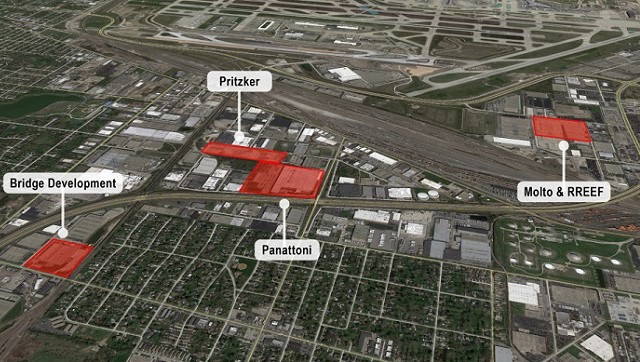 A number of major distribution buildings are rising near O’Hare Airport near Chicago, as developers attempt to satisfy users’ robust demand. Photo by JLL.
A number of major distribution buildings are rising near O’Hare Airport near Chicago, as developers attempt to satisfy users’ robust demand. Photo by JLL.
CHICAGO—As reported last week in GlobeSt.com, the North American big-box sector just finished a historic year, as speculative deliveries soared past build-to-suits, and users quickly moved to fill in much of the new space. And experts from Colliers International, which just released its latest Big Box Market Report, say the expansion will likely continue. Furthermore, the appetite among investors for these properties, defined as distribution buildings with more than 300,000 square feet and clear heights of 28’ or greater, is unlikely to abate.
“Institutional money is flowing into the industrial market, especially the distribution sector,” Jack Rosenberg, Colliers’ national director, logistics and transportation, tells GlobeSt.com. In fact, so many investors are trying to establish a foothold that “in 2016, we think that there was about $100 million in equity looking for class A distribution buildings that was not able to get placed.”
The intensity of the competition, which pushed down the average cap rate to just 5.3%, has changed how investors approach deals. “Institutional investors are trying to capture the best product far earlier,” Rosenberg says. Instead of concentrating their efforts on stabilized buildings, many have decided to buy long before tenants agree to occupancy.
And even though developers did 67% of the 87 million square feet finished last year on a speculative basis, a far greater proportion than in previous years, Rosenberg seems to have few worries that new supply will overreach demand this year. He says a client came to him in September 2015 looking for about 600,000 square feet, and needed it June. But nothing was available, and the firm had to go with a build-to-suit.
He expects all types of firms to continue restructuring their supply chains, moves that inevitably call for the construction of class A distribution centers, usually with 32’ clear ceilings or higher. “The importance of supply chain infrastructure to all corporations has been rising,” he says. “When I started in the business 30 years ago, CEOs typically did not have supply chain backgrounds, but that’s changing.” Firms looking to cut costs these days, especially ones in manufacturing, know a new supply chain can add millions to the bottom line, and many increasingly select executives with this kind of experience when top slots open up.
Leasing activity in 2016 did has keep pace with new development. Users leased 105 million square feet last year, an increase of 9.6% over 2015. And even with the record amount of new construction, the overall vacancy rate only rose 0.2 percentage points to 7.7%. Furthermore, by the end of 2016, effective rents reached $4.66, a 10.9% increase over 2015.
“We all know there is going to be a slowdown,” says Rosenberg, “we just don’t know when.”
But barring any unforeseen developments, the consensus is that 2017 will be another strong year.

















 Copyright © 2024 ALM Global, LLC. All Rights Reserved.
Copyright © 2024 ALM Global, LLC. All Rights Reserved.